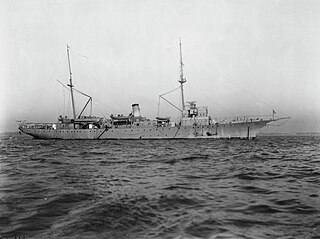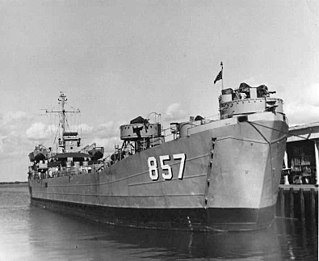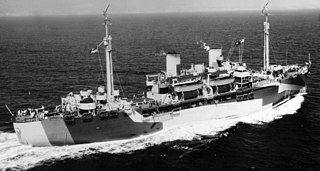
USS Abnaki (ATF-96) was the lead ship of the Abnaki class of fleet ocean tugs in the service of the United States Navy, named after the Abenaki tribe of Native Americans. She was laid down on 28 November 1942 at Charleston, South Carolina by Charleston Shipbuilding & Drydock, launched on 22 April 1943, sponsored by Mrs. James Mayon Jones, and commissioned at the Charleston Navy Yard on 25 November 1943. Abnaki earned three battle stars for service during the Korean War and 10 battle stars during the Vietnam War.

USS Haven (AH-12) was the lead ship of her class of hospital ships built for the U.S. Navy during World War II. Laid down as SS Marine Hawk, she was transferred from the Maritime Commission for conversion to a hospital ship, and served in that capacity through the end of the war. She was redesignated APH-112 in June 1946 for participation in Operation Crossroads, returning to her original AP-12 designation in October 1946. Haven participated in the Korean War and eventually ending her military career acting as a floating hospital in Long Beach, California. She was later converted to a chemical carrier and scrapped in 1987.

USS Sumner (AG-32/AGS-5) was a survey ship in the United States Navy. She was named in honor of Thomas Sumner. She was originally commissioned as a submarine tender as USS Bushnell (AS-2/AG-32), in honor of David Bushnell, the inventor of the first American submarine.

USS Luzerne County (LST-902) was an LST-542-class tank landing ship built for the United States Navy during World War II. Named after Luzerne County, Pennsylvania, she was the only U.S. Naval vessel to bear the name.

USS Etlah (YN-98/AN-79) was a Cohoes-class net laying ship built for the United States Navy during World War II. She was commissioned in April 1945 and spent her entire career in the Pacific Ocean. She was decommissioned in March 1947 and placed in reserve. She was recommissioned in August 1951 for Korean War service and remained active until May 1960. She was sold to the Dominican Republic in September 1976 as patrol vessel Cambiaso (P207). By 1994, Cambiaso had been removed from Dominican Navy service and hulked.

USS Reclaimer (ARS-42), was a Bolster-class rescue and salvage ship of the United States Navy. It was the only ship of the US Navy to be named Reclaimer.

USS Mender was a Gypsy-class salvage lifting vessel of the United States Navy. Originally designated LSM‑550, she was reclassified on 24 April 1945, and was laid down on 25 August 1945 by Brown Shipbuilding Corporation, Houston, Texas. Launched on 7 December 1945; and commissioned on 8 March 1946.

USS Sphinx (ARL-24) was laid down as a United States Navy LST-542-class tank landing ship but converted to one of 39 Achelous-class repair ships that were used for repairing landing craft during World War II. Named for the Sphinx, she was the only US Naval vessel to bear the name.

USS King County (LST-857) was an LST-542-class tank landing ship built for the United States Navy during World War II. Named after counties in Texas and Washington, she was the only U.S. Naval vessel to bear the name.

USS Silverstein (DE-534) was a John C. Butler-class destroyer escort in service with the United States Navy from 1944 to 1947 and from 1951 to 1958. She was sold for scrapping in 1973.

USS Preserver (ARS-8) was a Diver-class rescue and salvage ship commissioned by the U.S. Navy for service in World War II. She was responsible for coming to the aid of stricken vessels. Preserver was laid down by Basalt Rock Company in Napa, California, 26 October 1942, launched 1 April 1943, sponsored by Mrs. Walter F. LaFranz, and commissioned 11 January 1944.

USS Current (ARS-22) was a Diver-class rescue and salvage ship commissioned by the U.S. Navy during World War II. Her task was to come to the aid of stricken vessels.

USS Grasp (ARS-24) was a Diver-class rescue and salvage ship commissioned by the U.S. Navy during World War II. Her task was to come to the aid of stricken vessels.

USS Safeguard (ARS-25) was a Diver-class rescue and salvage ship in service with the United States Navy from 1944 to 1947 and from 1952 to 1979. She was then transferred to Turkey where she served as TCG Işın (A-589) until 2017.

USS Conserver (ARS-39) was a Bolster-class rescue and salvage ship acquired by the U.S. Navy during World War II. Her task was to come to the aid of stricken vessels.

USS Appling (APA-58) was a Gilliam-class attack transport that served with the United States Navy from 1944 to 1946. She was scrapped in 1969.

USS Koka (ATA-185) was a US Navy tugboat. Koka is from the phonetic spelling of Coca, formerly an Indian village in southern Arizona. Originally designated as ATR-112, she was redesignated as ATA-185 on 15 May 1944; launched 11 September 1944, by Levingston Shipbuilding Co., Orange, Texas; and commissioned on 16 November.
USS Oneota (YN-110/AN-85) was a Cohoes-class net laying ship which was assigned to protect United States Navy ships and harbors during World War II with her anti-submarine nets. Her World War II career was short due to the war coming to an end, but she was retained post-war sufficiently long to participate in atomic testing at Bikini Atoll.
USS Passaconaway (YN-114/AN-86) – sometimes called USS Skakamaxon -- was a Cohoes-class net laying ship which was assigned to protect United States Navy ships and harbors during World War II with her anti-submarine nets. Her World War II career was short due to the war coming to an end, but, post-war, she continued salvage operations, including those at Bikini Atoll, before being struck from the Navy in 1947.

USS Knudson (APD-101), ex-DE-591, later LPR-101, was a United States Navy high-speed transport in commission from 1944 to 1946 and from 1953 to 1958.


















